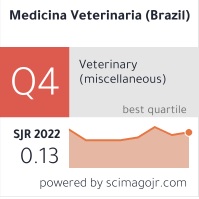Avaliação da interleucina-6 e do metabolismo do ferro em 20 cães saudáveis
DOI:
https://doi.org/10.26605/medvet-v17n4-5648Keywords:
capacidade total de ligação do ferro, capacidade latente de ligação do ferro, transferrina, ferritina, inflamaçãoAbstract
In inflammation, there is an increase in interleukin-6 (IL-6), a pro-inflammatory cytokine that stimulates the production of hepcidin. This hormone regulates iron metabolism, decreasing intestinal absorption and making iron unavailable inside cells. The main consequence of these alterations is anemia due to the unavailability of this mineral. To help the diagnosis, determine the prognosis and guide therapeutic decisions, laboratory evaluation of iron metabolism, hepcidin and IL-6 are important. The present study aimed to evaluate serum iron concentration, unsaturated iron-binding capacity (UIBC), total iron-binding capacity (TIBC), transferrin saturation (TS), IL-6 and hepcidin in healthy dogs. Twenty healthy adult dogs without specification of breed and sex and presenting C-reactive protein below 10 mg/L were evaluated. Iron concentration and UIBC were assessed by colorimetric method using Ferene and TIBC and IST were calculated. The determination of the serum concentration of IL-6 and hepcidin was performed by ELISA using specific kits for the canine species. The mean values obtained were: serum iron = 157.75 µg/dl; UIBC= 270.41 µg/dl; TIBC = 425.61 µg/dl; TS = 36% and IL-6 0.164 ng/ml. Of the 20 samples evaluated, only one showed a reading for hepcidin (16.9 ng/ml). There was no correlation between serum IL-6 concentrations and serum iron concentration, UIBC, TIBC and TS, suggesting that physiological variations of this cytokine do not interfere with iron metabolism in healthy dogs.Downloads
References
Avazi, D.O. et al. Evaluation of levels of interleukin-6, interleukin-8 and some haematologic parameters of dogs with cutaneous wounds. Cytokine, 113: 128-138, 2019.
Bhamarasuta, C. et al. Iron status and erythropoiesis response to darbepoetin alfa in dogs with chronic kidney disease. Journal of Veterinary Medical Science, 83(4): 601-608, 2021.
Bohn, A.A. Diagnosis of disorders of iron metabolism in dogs and cats. Veterinary Clinics of North America - Small Animal Practice, 43(6): 1319-1330, 2013.
Bregman, D.B. et al. Hepcidin levels predict nonresponsiveness to oral iron therapy in patients with iron deficiency anemia. American Journal of Hematology, 88(2): 97-101, 2013.
Cheney, A. et al. Interleukin-6 and thrombopoietin concentrations in dogs with carcinoma with and without thrombocytosis. Journal of Veterinary Internal Medicine, 36(1): 227-233, 2022.
Dabrowski, R. et al. Serum IL-6 and IL-10 concentrations in bitches with pyometra undergoing ovariohysterectomy. Acta Veterinaria Scandinavica, 57(1): 8-11, 2015.
Dale, J.C.; Burritt, M.F.; Zinsmeister, A.R. Diurnal variation of serum iron, iron-binding capacity, transferrin saturation, and ferritin levels. American Journal of Clinical Pathology, 117 (5): 802-808, 2002.
Girelli, D.; Nemeth, E.; Swinkels, D.W. Hepcidin in the diagnosis of iron disorders. Blood 127(3): 2809-2813, 2016.
Goddard, A. et al. Excessive pro-inflammatory serum cytokine concentrations in virulent canine babesiosis. PLoS ONE, 11(3): e0150113, 2016.
Grimes, C.N.; Giori, L.; Fry, M.M. Role of hepcidin in iron metabolism and potential clinical applications. Veterinary Clinics of North America - Small Animal Practice, 42(1): 85-96, 2012.
Hentze, M.W. et al. Two to Tango: regulation of mammalian iron metabolism. Cell, 142(1): 24-38, 2010.
Hohaus, S. et al. Anemia in Hodgkin’s lymphoma: The role of interleukin-6 and hepcidin. Journal of Clinical Oncology, 28(15): 2538-2543, 2010.
Hunter, C.A., Jones, S.A. IL-6 as a keystone cytokine in health and disease. Nature Immunology, 16(5): 448-457, 2015.
Kaneko, J.J; Harvey, J.W.; Bruss, M.L. Clinical Biochemistry of Domestic Animals. 6th ed. Oxford: Academic Press, 2008. 932p.
Kroot, J.J.C. et al. (Pre)analytical imprecision, between-subject variability, and daily variations in serum and urine hepcidin: Implications for clinical studies. Analytical Biochemistry, 389(2): 124-129, 2009.
Nai, A. et al. Hepcidin levels predict Covid-19 severity and mortality in a cohort of hospitalized Italian patients. American Journal of Hematology, 96(1): E32-E35, 2021.
Nikolic Nielsen, L.; Kjelgaard-Hansen, M.; Kristensen, A. T. Monocyte chemotactic protein-1 and other inflammatory parameters in Bernese Mountain dogs with disseminated histiocytic sarcoma. Veterinary Journal, 198,(2): 424-428, 2013.
Pires, L.S.A. et al. Parâmetros utilizados na avaliação do metabolismo do ferro em cães. Ciência Rural, 41(2): 272-277, 2011.
Rajamanickam, K. et al. Serum hepcidin as a clinical prognostic marker to discriminate the outcome of canine babesiosis. Indian Journal of Animal Research, 55(11): 1323-1329, 2021.
Rau, S. et al. Plasma interleukin-6 response is predictive for severity and mortality in canine systemic inflammatory response syndrome and sepsis. Veterinary Clinical Pathology, 36(3): 253-260, 2007.
Ruchala, P.; Nemeth, E. The pathophysiology and pharmacology of hepcidin. Trends in Pharmacological Sciences, 35(3): 155-161, 2014.
Schüttler, J.; Neumann, S. Interleukin-6 as a prognostic marker in dogs in an intensive care unit. Veterinary Clinical Pathology, 44 (2): 223-228, 2015.
Vizi, Z. et al. Serum hepcidin measurements in healthy dogs using liquid chromatography/tandem mass spectrometry. Veterinary Clinical Pathology, 49(2): 292-298, 2020.
Zaritsky, J. et al. Hepcidin - A potential novel biomarker for iron status in chronic kidney disease. Clinical Journal of the American Society of Nephrology, 4(6): 1051-1056, 2009.
Downloads
Published
How to Cite
Issue
Section
License
Copyright (c) 2023 Nina da Cunha Medeiros, Rosangela Locatelli Dittrich

This work is licensed under a Creative Commons Attribution-NonCommercial-ShareAlike 4.0 International License.
A Revista de Medicina Veterinária permite que o autor retenha os direitos de publicação sem restrições, utilizando para tal a licença Creative Commons CC BY-NC-SA 4.0.
De acordo com os termos seguintes:
Atribuição — Você deve dar o crédito apropriado, prover um link para a licença e indicar se mudanças foram feitas. Você deve fazê-lo em qualquer circunstância razoável, mas de nenhuma maneira que sugira que o licenciante apoia você ou o seu uso.
NãoComercial — Você não pode usar o material para fins comerciais.
CompartilhaIgual — Se você remixar, transformar, ou criar a partir do material, tem de distribuir as suas contribuições sob a mesma licença que o original.
Sem restrições adicionais — Você não pode aplicar termos jurídicos ou medidas de caráter tecnológico que restrinjam legalmente outros de fazerem algo que a licença permita.






